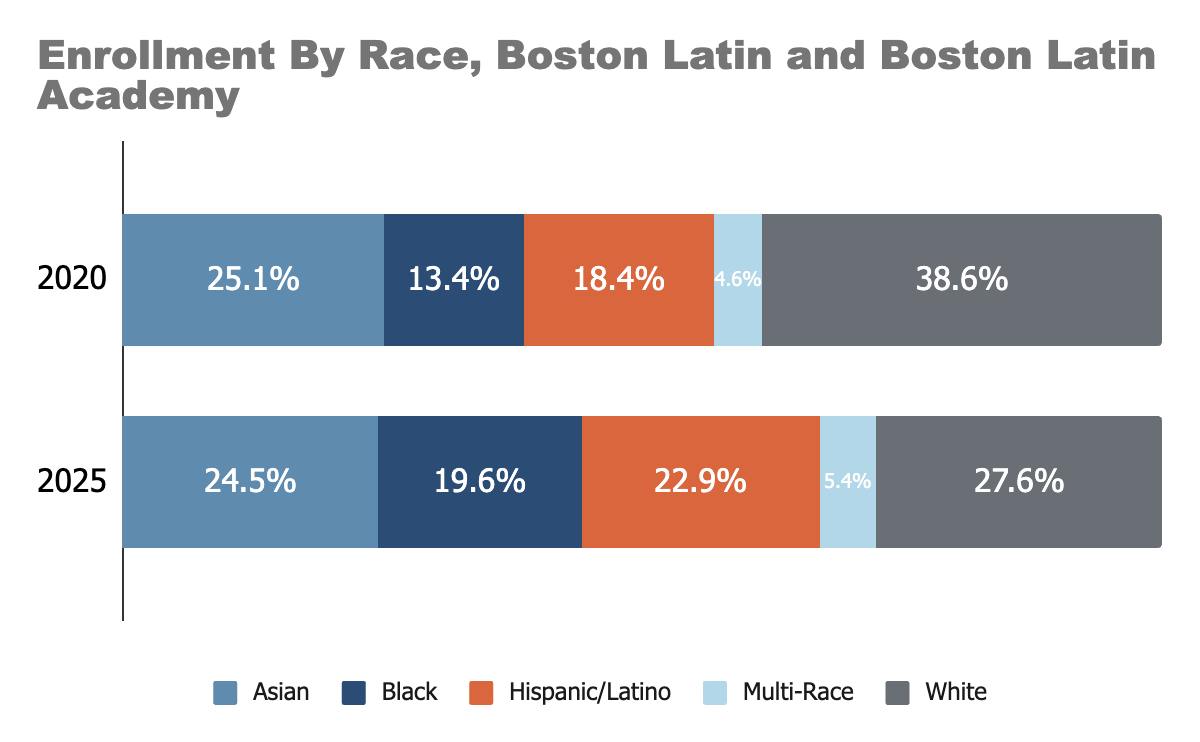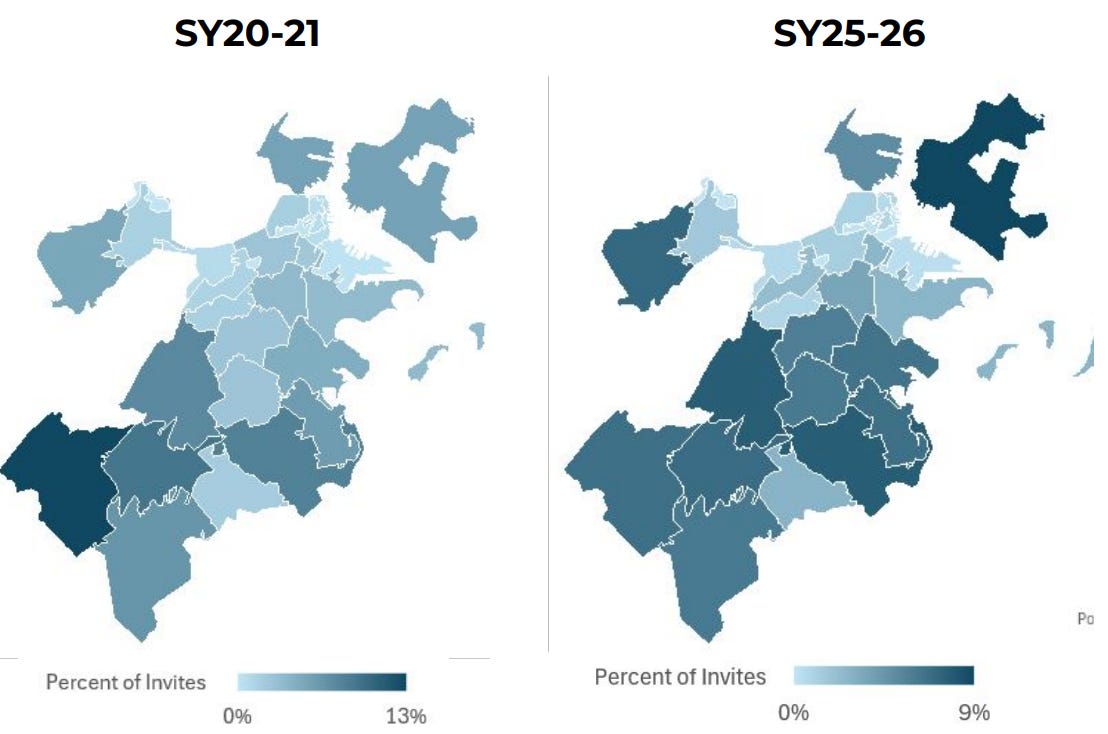Boston School Committee ended the school-year with a packed agenda and one topic inevitably garnered the most attention: exam schools. As in recent springs, BPS released a trove of data on exam school applications and invitations.
Although most headlines focused on potential changes to the admissions policy, the data clearly show the policy has functioned as intended.
The share of Black and Latino enrollment at Boston Latin School (BLS) and Boston Latin Academy (BLA) has grown by a factor of ~1/3.
Mindful of potential legal challenges, the policy achieved this shift in enrollment by race by leveraging Boston’s residential segregation and the correlation between race and income status. With grades and test scores, invitations are balanced equally across neighborhoods (using socioeconomic “tiers”) and students are awarded “bonus points” for admission for attending a high-poverty school. (The full, far more complex policy is here.)
The more even “blue” above reflects this redistribution, with some neighborhoods (East Boston, Roxbury, Dorchester) seeing substantially more invitations.
Close readers will note that the racial composition data didn’t include Boston’s third exam school, the O’Bryant School of Mathematics and Science (OB).
That’s because the O’Bryant’s demography didn’t change much and - following the logic of the policy - it didn’t have to. The school already closely mirrored the racial composition of the district.
Demand is clearly playing a role here. The O’Bryant is now the average top choice behind Boston Latin, surpassing Boston Latin Academy, which past data indicated was the common second option for applicants.
In most of the city, a student now needs a higher score to get a seat at the O’Bryant than at Boston Latin Academy (14-15).
But the more macro demand trend - which I wrote about in the Boston Globe last summer - is that fewer children are applying for the exam schools generally. Although the district notes a small increase in 7th grade applicants this year, the missing 9th grade data prevents any year-over-year conclusion.
Using just that 7th grade data illustrates the bigger point that fewer kids are applying to exam schools.
In releasing this level of data, the district offers a new insight. Fewer applications from students at non-BPS schools and with higher socioeconomic status (12-13) has contributed to the decline but they are not the driver. Substantially fewer BPS student applications have driven this trend, contributing to nearly 75% of the overall decline.
Demand impacts which students attend these schools, and also how many. 207 fewer students attend exam schools today than in 2020. It may even impact how many children attend BPS schools generally. The data report indicates nearly the majority of BPS students who do receive an exam school invitation unenroll from BPS (17).
There have been lawsuits and intense political pressure from corners of the city to tweak or overhaul aspects of the policy, most notably the bonus points system. This week, the district offered more data and simulations, and “beginning the process of re-examining what, if any, changes should be recommended.” In sum, nothing yet.
Ironically, the exam school admission policy has already been changed six times in six years. But the constant creation of new formulas seems to be less of a commitment to equity than the management of the political realities of scarcity. As long as exam schools exist and families want access to them, there will be a constituency watching weights and measures closely and advocating for their own advantage.
510 children met admission criteria this year and were not offered a seat (15). This doesn’t include many children who declined a seat because it was not their top choice or learned of their exam school spot after already choosing another school.
At a certain point, it makes sense to stop talking about how to build a better gate and just let more kids in. This is why in the past I have advocated for the expansion of exam school enrollment, specifically at the O’Bryant, whose shared facility with Madison Park sits on one of the largest public school sites in the entire country.
Confusing rules and saying “no” to kids and families are not winning strategies to reverse the long-term decline in enrollment and trust in the district. Access and meeting families’ needs should be the way forward with all of the city’s schools.
Three schools is not enough, but it is a good place to start.
Schools
Full Boston School Committee materials here. Biggest news was Superintendent Skipper’s evaluation and Lima Barbosa’s resignation opens up a seat.
Senate President Spilka is backing a school cell phone bill ban following a State House hearing this week.
As he is about to assume the role of Commissioner in Massachusetts, Pedro Martinez added to his lawsuit against the people he used to work with in Chicago. Part of this stems from a public disagreement about what to do about underenrolled schools.
Two different studies identify elementary school as the crossroads for most kids’ math proficiency. That may be particularly true for girls.
Following on last week’s piece on special education, a unanimous US Supreme Court decision may raise the bar for districts.
Three-year degrees were discussed at this week’s Board of Higher Education Meeting.
What are your kids doing - not doing - this summer?
Other Matters
Why should we be worried about expensive houses and cheap offices? A new book and interview with a BU professor explains economic shifts and risks for Boston.










